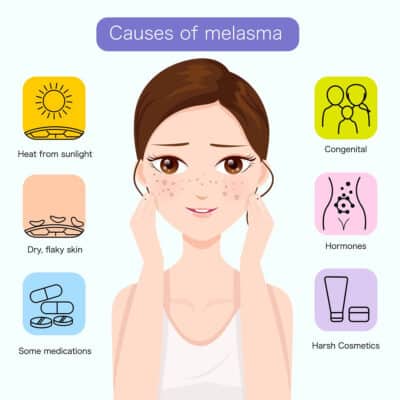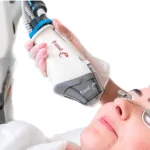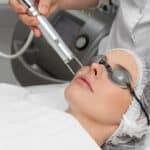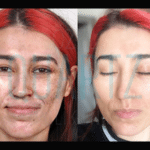 Melasma is sunspots that form on certain areas of the skin and are usually dark brown in color. It usually begins to occur after the age of 20. It is most commonly seen on the cheeks, forehead, chin and upper lip. Apart from the face area, it also occurs in areas of the body that receive a lot of sun, such as the forearm and neck. Sunspots, a common skin problem, are a condition that women are more prone to. Only 10% of men have the problem of sunspots. It is a common ailment, especially during pregnancy, so its name is also known as the “pregnancy mask”.
Melasma is sunspots that form on certain areas of the skin and are usually dark brown in color. It usually begins to occur after the age of 20. It is most commonly seen on the cheeks, forehead, chin and upper lip. Apart from the face area, it also occurs in areas of the body that receive a lot of sun, such as the forearm and neck. Sunspots, a common skin problem, are a condition that women are more prone to. Only 10% of men have the problem of sunspots. It is a common ailment, especially during pregnancy, so its name is also known as the “pregnancy mask”.
What is melasma?
Melasma is not a condition with serious side effects. It does not cause any symptoms. However, many of the people who suffer from this disorder are not satisfied with the appearance of melasma. Therefore, they decide to have sunspot treatment.
Melanin-producing cells, which color in areas with sunspots, produce more color than in areas without spots. Normally, the number of color cells in normal skin is equal to the number in the area where the spot is located. But they work more in the area with sunspots. As a result, the stained areas instantly darken.
Melasma is more common in people with dark skin. In addition, people with a family history of this disease are more prone to the disease. These sunspots, which appear mostly on the face area, occur bilaterally and symmetrically. These spots usually darken in the summer and during the solarium. This is a very common ailment that can be treated.
What causes melasma?
 The cause of melasma formation has not been definitively resolved yet. It occurs when cells that give color to the skin, called melanocytes, produce more than normal the color pigment melanin. Melanocytes are more active in dark-skinned people. Therefore, they are more likely to develop sunspots than fair-skinned people. There are many triggering factors that cause melasma to occur. Some of these are those:
The cause of melasma formation has not been definitively resolved yet. It occurs when cells that give color to the skin, called melanocytes, produce more than normal the color pigment melanin. Melanocytes are more active in dark-skinned people. Therefore, they are more likely to develop sunspots than fair-skinned people. There are many triggering factors that cause melasma to occur. Some of these are those:
Exposure to the sun: UV rays emitted by the sun stimulate melanocytes. Even a small amount of sun exposure can cause sunspots. In the summer, this situation gets worse.
Hormone change: It is a common ailment that occurs frequently in pregnant women. The type seen in pregnant women is called pregnancy mask or chloasma. Birth control pills and hormone replacement therapy are also among the factors that trigger melasma.
Cosmetics: Using the wrong cosmetic creams can worsen melasma. It is not right to prefer cosmetic products that irritate the skin.
Apart from these, hormone replacement therapy, genetic predisposition in family history, having dark skin and being female are among the triggering factors for the formation of sunspots. In addition, disorders in ovarian and thyroid functions also fuel melasma disease. In general, excessive sun exposure, hormonal changes, use of wrong cosmetic products, genetic factors and some innate inherited features that cannot be changed are among the factors that trigger melasma formation.
What are the types of melasma?
There are three types of melasma according to the depth of pigmentation in the skin. These:
Epidermal: Epidermal melasma is the most easily diagnosed type during dermatological examination and this type gives the best response to treatment. This species has a dark brown color and sharp lines.
Dermal: This species takes on a color with light brown or bluish tones. It has blurry edges, not sharp lines. Diagnosis and treatment can be more difficult and troublesome than other types.
Mixed melasma: The most common type. It occurs as both brown and bluish spots. The response rate to treatment is very high.
Unnamed type: It occurs more on the skin of dark-colored individuals. It is characterized by excess melanocytes.
Where is melasma most common?
Melasma is most common in the face area. It is observed that it occurs more in the forehead area, chin, cheeks and upper lip. It also occurs on the forearms and neck, from other areas of the body with intense sun. There are 3 types of melasma according to the location of the spots where the melasma is seen. These:
Centrofacial: It is concentrated in the center of the face. It is frequently seen on the forehead, cheeks, mustache area, nose and chin from areas exposed to intense sun. This is the most common form.
Malar: It is observed that it occurs mostly in the cheek region.
Mandibular: It occurs more frequently in the lateral regions of the lower jawbone.
Another place where melasma occurs is the forearms. The most important reason for its occurrence in the forearms is hormone replacement therapy. It occurs more in summer. What are the symptoms of melasma?
It is usually concentrated in the following areas of the skin:
- It is frequently seen in the face area. It settles on the forehead, cheeks, nose and upper lip.
- May also appear on the shoulders and upper arms
- It can appear symmetrically on both cheeks or only in the mustache area.
- It occurs in areas exposed to intense sun on the chin line and neck.
Who gets melasma?
Both genetic and racial factors play an important role in the formation of melasma. It is possible to come across individuals who have had this disease in the family history of an individual who frequently experiences this disease. Generally, exposure to intense sunlight during childhood or adolescence increases the likelihood of sunspots in the future. However, it is not true that every individual who is exposed to excessive sun will get this disorder. Some people are more fortunate in this respect. Sunspots are most common in women and dark-skinned individuals. It occurs in 90 percent of women and 10 percent of men. According to studies, the incidence of sunspots is higher in women of Latin, Asian and Middle Eastern origin.
Is melasma permanent?
This disease appears as a chronic disease. In some cases, it is lifelong, while some types are mostly temporary. Various methods are used in its treatment. In this way, it is aimed to pass the disease milder and to control it. It is usually under control with the right treatment and prevention methods.
How is melasma diagnosed?
The diagnosis of melasma can be easily made by a dermatologist with a simple skin examination. In addition to the examination, the dermatologist may also ask about the medications you use and any other disease you have. Sometimes this disease shows symptoms similar to other skin diseases. For this reason, the dermatologist may take a small piece of skin to make the most accurate diagnosis.
Apart from this, the dermatologist can examine the skin with a device called a wood lamp to understand the depth of melasma. The Wood’s lamp technique is a frequently used test technique in the diagnosis of this disease. With the light emitted by the Wood’s lamp, it is aimed to get an idea of whether the melasma is located superficially or deeper.
How is melasma treated?
Sunspots are not a condition that causes a serious reaction. But the treatment may take a certain period of time as it occurs. It may take months for the spots to disappear completely. In some skin types, the spots go away without the need for any treatment. For example, these spots, which appear during pregnancy and are also called pregnancy masks, may disappear spontaneously after birth. The course of treatment is not short. It is a time to be patient for both the patient and the doctor. During the treatment period, attacks may occur at certain intervals, especially in the summer months. It’s normal. The treatment can completely eliminate the spots, with 100% effect in some light-skinned people, but the possibility of recurrence should still be known. Dark-skinned people, on the other hand, have a lower success rate and a higher chance of recurrence compared to light-skinned people. In light-skinned individuals, the treatment can get results within weeks, but in dark-skinned individuals, the treatment process takes months.
- The most effective method in the treatment of sunspots is protection from the sun. It is necessary not to be exposed to intense and excessive sun, to be in cool areas as much as possible, to use a suitable sunscreen cream before going out, to wear the right clothes, and to wear a hat and glasses.
- Cream therapy is also among the most frequently applied treatment methods. There are many whitening creams available. These creams do not damage melanocytes. On the contrary, they are effective by reducing the pigment production of melanocytes. Creams containing hydroquinone are one of the most widely used cream groups to reveal the discoloration of the skin against sunspots. Starting treatment with creams containing low hydroquinone prevents skin irritation and prevents itching.
- In advanced cases, creams containing tretinoin and corticosteroids can be used together, as well as creams containing hydroquinone.
- Hydroninone should not be used for more than 3 months without the control of a dermatologist.
- Creams containing vitamin C, vitamin B3, alpha arbutin, tranexamic acid and kojic acid can also be used as they reduce melanin synthesis.
- During the treatment, cosmetic products should not be used without the doctor’s recommendation, dermapen, plasmapen, mesotherapy, etc. procedures should not be performed in places where there is no dermatologist supervision, on the contrary, these situations may increase staining.
- Apart from these, if the doctor deems it appropriate, various treatment methods such as laser treatments, chemical peeling, mesotherapy and PRP are also applied.
How to take precautions against melasma? Here are the recommendations
- The most effective way to prevent melasma is to be protected from the sun as much as possible. It is necessary to use daily sunscreen constantly. Sunscreen should be applied especially to areas exposed to the sun. Avoiding the sun is the most common treatment. Sun rays trigger and stimulate melasma. Thus, sunspots increase. It is extremely important to use sunscreen cream, even on cloudy days. Apart from this, care should be taken to stay in the shade as much as possible. Sunscreen should be renewed every 2 hours.
- Skin care routine should be preferred with the recommendation of a dermatologist. Care products that do not cause any burning or stinging should be used. Any active substance that irritates the skin can exacerbate melasma.
How much is melasma treatment? Melasma treatment prices
Treatment of melasma is determined according to the type and intensity of the disease after a comprehensive examination. The areas where melasma is concentrated and the patient’s preference also affect the treatment method to be applied. Depending on all these, pricing also varies according to the treatment method to be applied. You can reach our clinic by calling +90212 241 46 24 for the most accurate price information for you and for all your questions.












